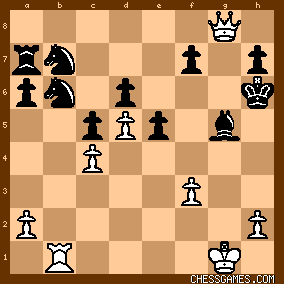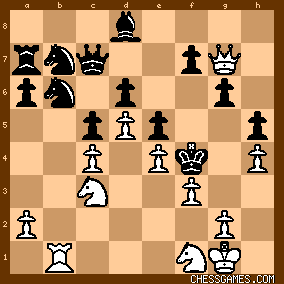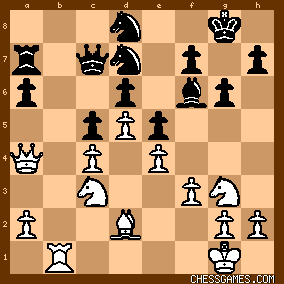|
< Earlier Kibitzing · PAGE 3 OF 3 ·
Later Kibitzing> |
| Jul-24-10 | | SuperPatzer77: Addition to my first analysis of "Black resigns in lieu of 39...Kh3", it is 40. Rb2! (instead of 40. Nd1!, threatening 41. Rh2#). White can choose either 40. Rb2 or 40. Nd1 to force mate in two moves. SuperPatzer77 |
|
| Jul-24-10 | | SuperPatzer77: <Not> I agree with your commentary about 38. Nf5+ - more accurate. Thanks to <OhioChessFan> - I overlooked 40...Nxd5. White's strong reply to 40...Nxd5 is 41. cxd5! 38. Nf5+! Kg5 (instead of 38...gxf5), 39. Qh6+ Kf6 (forced), 40. g4! (threatening 41. g5#) Nxd5! (only move), 41. cxd5! hxg4, 41. Qh4+ g5, 42. Qh6#  Kudos to Sergio Estremara Panos!!
SuperPatzer77 |
|
| Jul-24-10 | | kevin86: After the king chase,a new soldier will enter the fray-white's queen rook-to deliver the bad news. |
|
| Jul-24-10 | | gofer: I suppose that the queen was on a4 two moves earlier, the king was on g8 and the Nb6 was on d7, then for some foolish reason black played Nb6 attacking the queen on a4, but this lead to disaster... 32 ... Nb6
33 Qe8+ Kg7
and we manage to get to the strange position that we are now in. But this is horrible for black, the fianchetto DSB has left g7 and left the pawns very weak. White can completely control the dark squares with sacrifices of Bh6+ or Nh5+. The white squares around the king are already controlled by the white pawns on d5 qand e4 plus the queen, so we have the start of a mating net. Time to close the net... 34 Bh6+ ...
1) The acceptance is a quick death
34 ... Kxh6
35 Qf8+ Kg5
36 Qg7! ...
now the mating net is nearly complete as the all important f6 retreat square for the king is now blocked 36 ... f6 37 h4+ Kf5 (Kxh5 Qh6+ Kxg3 Ne2#) 38 Kf2 any move 39 Ne2# 36 ... Qe7/f5/Bf6 37 h4+ Kf5 (Kxh5 Qh6+ Kxg3 Ne2#) 38 Qh6+ (Bg5 Qxg5# or Kxg3 Ne2#) g5 39 Kf2 any move 40 Ne2# Main Line
36 ... h5
37 h4+ Kxh4 (Kf5 38 Qh6+ Kxg3 39 Ne2+ Kxh4 40 g3+ Kh3 41 Kf2 Kh2 42 Qc1 anymove 43 Qh1#) 38 Kf2! ...
Now the h file is open for the rook and the forced sequence 39 Rh1+ Kg5 40 Rxh5+ Kf5 41 Ne2# is coming against any
defense other than moving the king, so black must move the king!!! 38 ... Kg5
39 Rh1 h4
But the sequence still works!
40 Rxh4 any move other than Kxh4 (Kxh4 Qh6#)
41 Rh5+ Kf5
42 Ne2#
2) The refusal is slower but just as painful!
34 ... Kf6
35 f4 ...
35 ... Qe7/Be7 36 Qh8#
35 ... Qd7 36 fxe5+ dxe5 37 Rf1#
35 ... Nd7 36 fxe5+ Nxe5 37 Rf1+ Nf3 38 Rxf3#
35 ... exf4
36 Rf1 g5 (black cannot allow Rxf4#)
37 Nf5! ...
Now black has closed the noose even tighter. The king only has g6 available for an "escape" and that has to be taken immediately or Qg8 will close this too, with Qg7# to follow, but Kg6 is not much help... 37 ... Kg6 38 Qg8+ Kh5 39 Qxh7 f6 40 Bg7+ Kg4 41 h3#
So it looks like black has to give up the queen!
37 ... Qd7
38 Qh8+ Kg6
39 Qg7+ Kh5
40 Qxh7 ...
and its all over...
40 ... Qxf5
41 exf5 Kg4
42 Bg7 f3
43 Qh3+ Rxf3#/Qxf3#
Time to check! |
|
| Jul-24-10 | | sethoflagos: I first looked at 34 Nf5+ Kf6 35 Qh8#, which is good except I can't see anything after 34...gxf5. The other obvious force is 34 Bh6+. If 34...Kxh6 35 Qf8+ Kg5 36 Qg7(!) cuts off king's retreat and threatens 37 h4+ Kxh4 38 Qh6+ Kxg3 39 Ne2#. If 37...Kf4 38 Kf2 followed by 39 Ne2# (38...Bxh4 39 Qh6+ Bg5 40 Ne2#). 36...Kf4 37 Kf2 Kg5 38. h4+ and mate on h4 or f4 (37...Bh4 38 Qh6+ Bg5 39 Ne2# / 37...Bg5 38 Ne2#). If the king rejects the bishop sacrifice with 34...Kf6, 35 Qf8 followed by 36 Bg5+ Kxg5 37 Qg7 transposes to the above (except 35...g5 36 Bxg5+ Kg6 37 Qg8#). |
|
| Jul-24-10 | | CHESSTTCAMPS: Although material is even, white is obviously vastly superior in this closed position. Not only is black's undisciplined army clustered in one quandrant with little mobility, virtually none of black's pieces offers any protection to black's isolated king. The situation cries out for a king hunt: 34.Bh6+!!
As obvious as this may be to an experienced player, the two exclamation marks are deserved because any piece sac requires accurate calculation, and the visualization required in king hunts is more demanding than many sacrificial situations. I backtracked briefly to look at Nf5+/Nh5+, but Bh6+ is much more obviously forcing. Now there are two major branches: A) 34... Kf6 35.f4! ( Threatens mate in two. 35.Qh8+? is obviously winning, but lets the BK escape the mating bind.) ef 36.e5+ de 37.Nce4# A.1) 35... g5 36.Bxg5+ Kg7 (Kg6 37.Qg8#) 37.Nf5+ Kg6 38.Qg8+ Kh5 39.g4# A.2) 35... Be7 36.fe+ Kxe5 (de 37.Rf1#) 37.Qxf7 (threatening Bg7+) Kd4 38.Nge2+ (Qg7+ Kxc4 39.Nce2 Na4 offers resistance) Kxc4 39.Qf4 Nxd5 40.exd5+ Kd3 41.Qe4+ Kxd2 42.Rd1# A.3) 35... Qe7 36.Bg5+ is simplest.
A.4) 35... (Other) 36.fe+ de 37.Rf1#
B) 34... Kxh6 35.Qf8+ Kg5 36.Qg7!
A typical tactic in king hunts. In such situations it is more important to shut off escape routes for the hunted king than it is to keep checking. With the king being drawn deep into enemy territory, a piece deficit seems almost trivial. See Imbaud-Strumilo (1922) for a more stunning and complex example. 36... f5 (or f6 and several other moves) 37.h4+ Kf4 (Kxh4 38.Qh6+ Kxg3 39.Qh2#) 38.Kf2! Qxg7 39.Nce2# B.1 36... h5 37.Nf5! (the most difficult move for me to find) h4 38.Qh6+ Kf6 39.Qxh4+ g5 40.Qh6# B.1.1 37... Kf4 38.Kf2 followed by g3+/#
B.2 36... Kf4 37.Qh6+ Bg5 (g5 38.Kf2! is simplest) 38.Nce2+ Ke3 39.Qxg5+ Kd3 40.Rb3+ Kxc4 (or Kxc2) 41.Qc1#! is prettiest. I think this covers the key lines. Time to see what happened.... |
|
| Jul-24-10 | | sethoflagos: Oops, missed 36...h5 |
|
Jul-24-10
 | | scormus: Interesting game. As often, or thematic (whatever that means), in the Kings Indian Saemisch, W gets a lot of space and play on the Q-side, then suddenly all the pressure diverts to B's K-side. OK, I'm stalling because I didn't get this one. 34. Bh6+ and 35 Qf8+ were easy enough to find, but I tried a long time with 36 h4, and 37 h4 after some other move. I failed to see the strength of 36 Qg7, the key move, even though I realised W needed to keep the BK out of the bolt hole f6 and its escape to the Q-side. After 36 Qg7! B is lost whether he plays the game move or tries 36 ... f5. Nice to read that 36 h4+ was winning, even if less directly then than 7 alternatives. Got 2 so far this week, and only Sunday's insanity to come. I feel the way I imagine Andy Schleck is feeling. No, worse than that. I dont have reason to claim any satisfaction. |
|
| Jul-24-10 | | Ferro: I was admitting to begin with Bh6+ KxB and later to continue with the Queen Qf8+ Kg5, and finally h4!+ But it me was going away... |
|
| Jul-24-10 | | David2009: Revisiting my post S Estremera Panos vs L Cisneros, 1991 and reading others' posts I see I was completely wrong to claim 37.h4+ as a blunder: after Kxh4 
click for larger view 38.Nf5+ Kg5 the win is still there:
<OhioChessFan: [snip] 39. Qh6+ Kf6 40. g4! Nxd5 41. cxd5 hxg4 42. Qh4+ g5 43. Qh6++> Exactly. 40 g3 as suggested by <morfishine> also works (slower). Finally, <vaskokibika: I like my solution:> 38. Qh6 <(thematic)>. I do too, especially <Once>'s smothered mate variation 38...Bg5!? 39 Qxh5+! Back to the original puzzle, 34 Bh6+ Kxh6 35 Nf5+ turns out to win after all (just) after 35....gxf5 36.Qf8+ Kg6 37.exf5+ Kxf5 38.Ne4 Kg6 39.Qg8+ Kh6 40.g4 Qe7 41.g5+ Qxg5+ 42.Nxg5 Bxg5 
click for larger view
Now 43. Rxg6 crashes through eventually, but Crafty End Game Trainer puts up a stiff resistance. Online link (you are White):
http://www.chessvideos.tv/endgame-t...
I needed several tries to win. |
|
| Jul-24-10 | | SuperPatzer77: <ChessTTCamps> ...A.1) 35... g5 36.Bxg5+ Kg7 (Kg6 37.Qg8#) 37.Nf5+ Kg6 38.Qg8+ Kh5 39.g4#> White's 39th move g4+ is not a mate. That's not a good move. The correct move is 39. Qxh7+ Kg4, 40. Qh4#  SuperPatzer77 |
|
| Jul-24-10 | | ounos: Brilliant. I particularly like the variation 37. h4+ <Kf4> 38. <Nf1!> (another silent killer move, in similar spirit to <36. Qg7!>
click for larger viewThread is Ne2#. e.g. 38. ...Bxh4 39. Qh6+ (blocking g5) and 40. Ne2# |
|
| Jul-24-10 | | CHESSTTCAMPS: Crafty played right into my B.1 line, so I think that an immediate 37.Nf5 is a slight improvement over the game line, though not as pretty as the mate that <Once> diagrammed. |
|
| Jul-24-10 | | SuperPatzer77: < ounos: Brilliant. I particularly like the variation 37. h4+ <Kf4> 38. <Nf1!> (another silent killer move, in similar spirit to <36. Qg7!>> <ounos> Well done!!! I like your analysis better than mine. :-) ounos is a Greek word for road, right??? I'm just curious. SuperPatzer77 |
|
| Jul-24-10 | | CHESSTTCAMPS: <Once>
Thanks for the laughs that I get from your posts. BTW, I thought that English bakery bread (at least in 1975 when I was living there) was quite good! <SuperPatzer77:
< ...A.1) 35... g5 36.Bxg5+ Kg7 (Kg6 37.Qg8#) 37.Nf5+ Kg6 38.Qg8+ Kh5 39.g4#>
White's 39th move g4+ is not a mate. That's not a good move. The correct move is 39. Qxh7+ Kg4, 40. Qh4#> 
click for larger viewYou are correct and thanks for catching the error. I did all analysis from the puzzle position and in this line, I must have shifted the h2 pawn to h3 in vizualizing the position. Fortunately, 39.g4+ is not a blunder (in fact, Kxg4 40.Bxd8+ is mate next), but as you note, there is a quicker mate available. Have you yourself attempted an extensive analysis using this method? |
|
| Jul-24-10 | | CHESSTTCAMPS: <..I must have shifted the h2 pawn to h3 in vizualizing the position. > In fact, this is classic "retained image" - I actually visualized the f4 pawn on f3, as it is in the puzzle position. |
|
| Jul-24-10 | | tacticalmonster: Theme: King hunt
Candidate: 34 Bh6+
a) 34 Kxh6 35 Qf8+ Kg5 36 Qg7! f5 (36 h5 37 Nf5! h4 38 Qh6+ Kf6 38 Qxh4+ g5 39 Qh6#) (36 f6 37 Nf5 Kf4 38 Ne2+ Kg5 39 h4+ Kh5 40 g4 mate) 37 h4+ Kf4 (37 Kxh4 38 Qh6+ Kxg3 39 Ne2 mate) 38 Qh6+ g5 39 Kf2! any 40 Ne2 mate b) 34 Kf6 35 Rxb6! Qxb6 36 Nf5! gxf5 37 gxf5 Kxf5 (37 Qc7 38 g4! Qe7 39 Ne4 mate) 38 Qxf7+ Bf6 39 g4 mate. |
|
| Jul-24-10 | | zanshin: I got the idea of Bh6+, Qf8+ and h4+ to lure the King out ... so maybe partial credit. <dzechiel: I'm wondering, does 38...Kg5 put up any more resistance that the text?> Yes, but not enough ;-)
[Mate in 5] d=13 38...Kg5 39.Qh6+ Kf6 40.g4 Nxd5 41.cxd5 hxg4 42.Qh4+ g5 43.Qh6# (0:00:58) 2514kN [Mate in 2] d=13 38...gxf5 39.Kf2 f4 40.Rh1# (0:00:58) 2529kN |
|
Jul-24-10
 | | Jimfromprovidence: I'm very late to the puzzle today.
Overall, it's unusual to have a forced mate as a solution for a Saturday puzzle, particularly with one that began one move before the puzzle position. Concerning the game as a whole, to me it seems black played in a disorganized fashion and very passively. In fact, black did not have one piece land below the 4th rank. Most of white's attacking moves were obvious, but black's knights and rooks kept getting into each other's way.
Black finally tripped up beginning with 31...Nd6. 31.. Nd8, below, prevents 32 Qd6 and allows the knights to go to either side of the board if needed. 
click for larger view Regarding the post of <BOSTER>, I like the set-up of progressively diffficult puzzles because it gives you one benchmark you can use to measure your progress. It's just one tool, though. But from the puzzle solving along with reading the kibitzes, it's helped me a lot in my understanding of the game. |
|
| Jul-24-10 | | tacticalmonster: My variation b) is too long and it only allows White to win a piece. < dzechiel > had something better. If Black declined the Bh6 sacrifice and play 34 Kf6. White has 35 f4! If 35 exf4 36 e5+! dxe5 37 Ne4#. If 35 Nxc4 36 Rf1 Ne3 37 fxe5#. All these variations involve bringing the b1 rook and c3 knight into the attack. |
|
| Jul-24-10 | | ounos: <SuperPatzer77: ounos is a Greek word for road, right??? I'm just curious.> No, that's "odos" (ïäïò). Ounos is greek for Hun. By the way, as others had analyzed earlier, 37. ...Kf4 38. <Kf2> also wins, so <Nf1> was just one of the options. |
|
| Jul-24-10 | | Kapablanca: Why not 39. Kf2. I think it is the shortest, easier and elegant way.
We all missed it... |
|
| Jul-24-10 | | Jim Bartle: Yes, Kf2 is very nice, leaving the black king helpless. |
|
| Jul-24-10 | | Kapablanca: Black is defenceless agains 40. Rh1 check mate. That is the idea and I still find it the shortest, easier and elegant way to end the game. |
|
| Jul-24-10 | | BOSTER: <OhioChessFan> <I understand BOSTER point>.
Thanks. This means that I am not alone.
<Once> <If something is worth doing, it is worth doing well>. Thanks for greeting from Paris.
<al wazir> <About rushing. I don't agree>.
Because most <CG> puzzles are tactics , and GM Soltis has opinion that " if you don't spot a winning shot in the first moments you look at a position, you are not going to find it after 10 or 20 min." Maybe you are right.
<Nostrils> < I feel that in studing these positions players here are developing instinct... which will transfer for their game>.
You are lucky if you believe it! |
|
 |
 |
|
< Earlier Kibitzing · PAGE 3 OF 3 ·
Later Kibitzing> |





